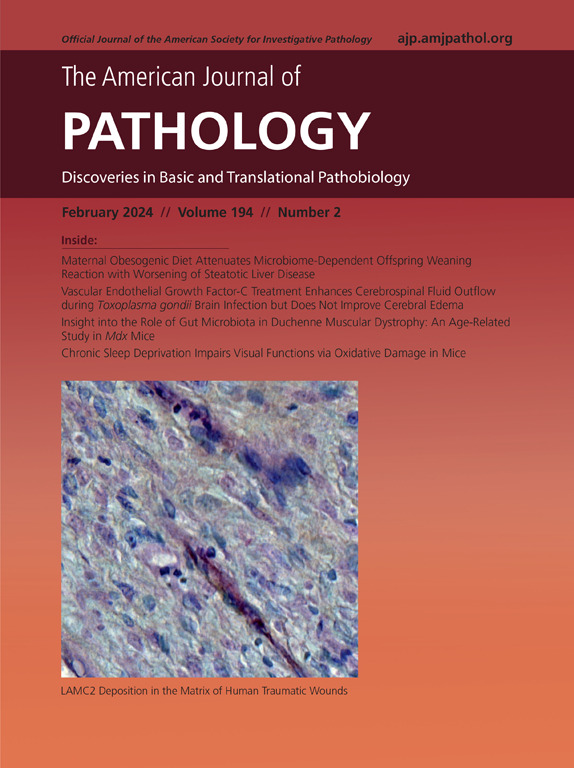PARP-1和PARP-2在b细胞淋巴瘤中的致病作用和治疗意义
IF 3.6
2区 医学
Q1 PATHOLOGY
引用次数: 0
摘要
b细胞淋巴瘤是一种异质性的恶性肿瘤,其特征是复杂的遗传、表观遗传和微环境改变。DNA损伤反应(DDR)中的缺陷是淋巴瘤发生的关键驱动因素,可以通过靶向关键的DDR调节因子如聚(adp -核糖)聚合酶-1 (PARP-1)和PARP-2来利用治疗漏洞。临床前研究表明,ddr缺陷性b细胞淋巴瘤对PARP-1/PARP-2抑制高度敏感,使用非选择性PARP抑制剂(PARPi)进行的早期临床试验,无论是单独治疗还是与化疗、免疫治疗或表观遗传药物联合使用,都取得了令人鼓舞的结果。然而,越来越多的证据表明,PARP-1和PARP-2在b细胞淋巴瘤的发病机制中发挥着不同的作用:PARP-1的缺失加速了淋巴瘤的发生,而PARP-2的缺失延缓了肿瘤的进展。这些发现挑战了目前泛parp抑制的范式,并强调了对异构体选择性策略的需求。尽管parp -1选择性抑制剂已进入hr缺陷肿瘤的临床试验,但parp -2选择性抑制剂的开发仍处于早期阶段。未来的研究应优先考虑parp -2靶向治疗的设计,结合生物标志物驱动的患者选择和合理的组合策略,增强DNA损伤和调节肿瘤免疫微环境。选择性靶向PARP-2为改善侵袭性、难治性或复发b细胞淋巴瘤患者的预后提供了有希望的方法,并代表了在血液恶性肿瘤中推进精确肿瘤学的关键一步。本文章由计算机程序翻译,如有差异,请以英文原文为准。
Poly (ADP-Ribose) Polymerase 1 and 2 in B-Cell Lymphoma
B-cell lymphomas represent a heterogeneous group of malignancies characterized by complex genetic, epigenetic, and microenvironmental alterations. Defects in the DNA damage response (DDR) are critical drivers of lymphomagenesis, generating therapeutic vulnerabilities that can be exploited by targeting key DDR regulators, such as poly (ADP-ribose) polymerase-1 (PARP-1) and PARP-2. Preclinical studies demonstrate that DDR-defective B-cell lymphomas are highly sensitive to PARP-1/PARP-2 inhibition, and early-phase clinical trials using nonselective PARP inhibitors, either as monotherapy or in combination with chemotherapy, immunotherapy, or epigenetic agents, have yielded encouraging results. However, emerging evidence reveals that PARP-1 and PARP-2 play distinct roles in B-cell lymphoma pathogenesis: loss of PARP-1 accelerates lymphomagenesis, whereas loss of PARP-2 delays tumor progression. These findings challenge the current paradigm of pan-PARP inhibition and highlight the need for isoform-selective strategies. Although PARP-1–selective inhibitors have entered clinical trials for homologous recombination–deficient tumors, the development of PARP-2–selective inhibitors remains at an early stage. Future research should prioritize the design of PARP-2–targeted therapies, coupled with biomarker-driven patient selection and rational combination strategies that enhance DNA damage and modulate the tumor immune microenvironment. Selectively targeting PARP-2 offers a promising approach to improving outcomes for patients with aggressive, refractory, or relapsed B-cell lymphomas and represents a critical step forward in advancing precision oncology within hematologic malignancies.
求助全文
通过发布文献求助,成功后即可免费获取论文全文。
去求助
来源期刊
CiteScore
11.40
自引率
0.00%
发文量
178
审稿时长
30 days
期刊介绍:
The American Journal of Pathology, official journal of the American Society for Investigative Pathology, published by Elsevier, Inc., seeks high-quality original research reports, reviews, and commentaries related to the molecular and cellular basis of disease. The editors will consider basic, translational, and clinical investigations that directly address mechanisms of pathogenesis or provide a foundation for future mechanistic inquiries. Examples of such foundational investigations include data mining, identification of biomarkers, molecular pathology, and discovery research. Foundational studies that incorporate deep learning and artificial intelligence are also welcome. High priority is given to studies of human disease and relevant experimental models using molecular, cellular, and organismal approaches.

 求助内容:
求助内容: 应助结果提醒方式:
应助结果提醒方式:


